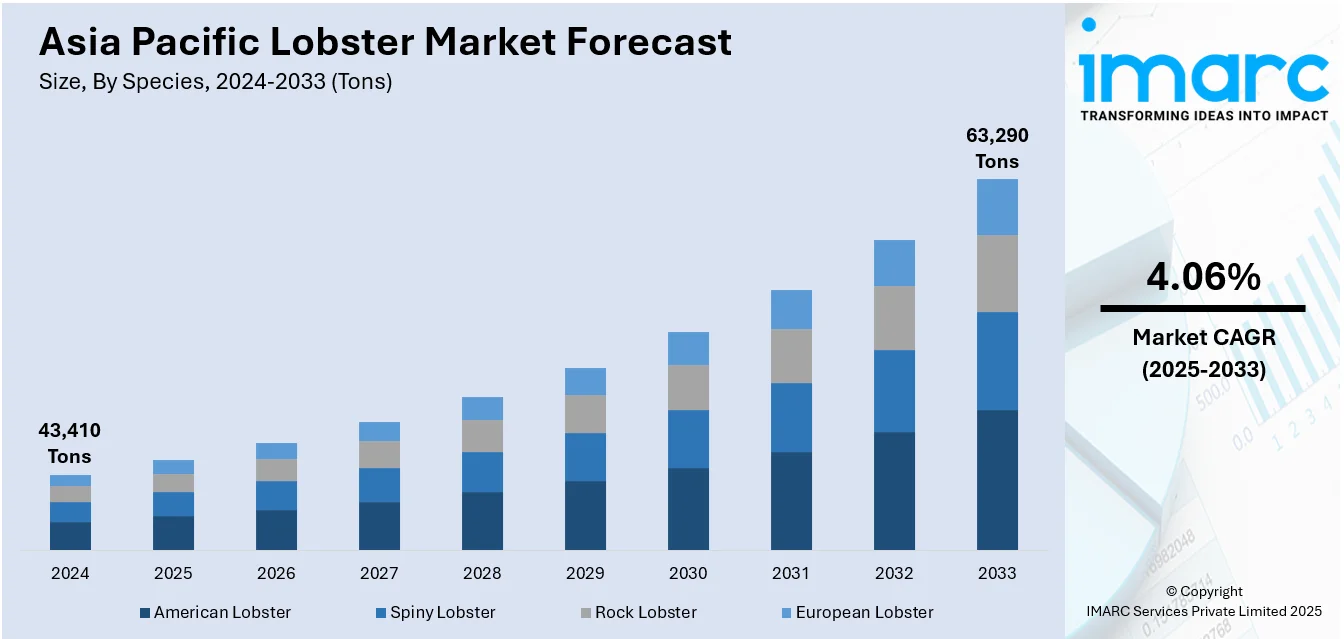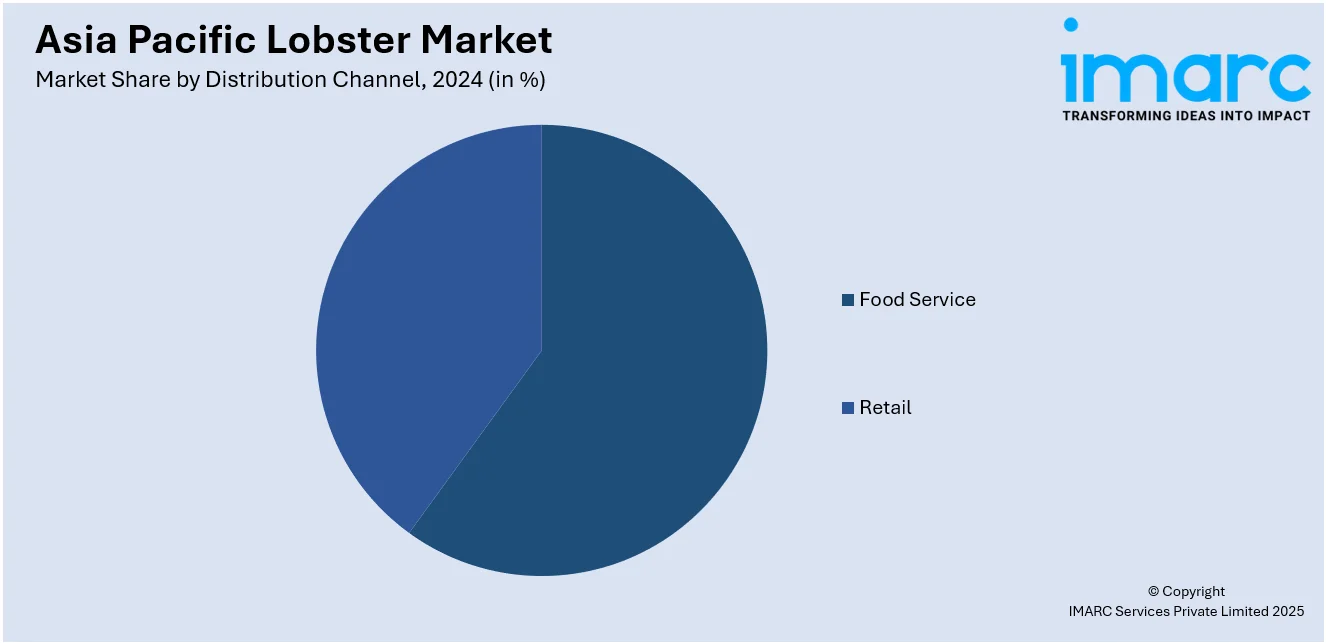
Asia Pacific Lobster Market Size, Share, Trends and Forecast by Species, Weight, Product Type, Distribution Channel, and Country, 2025-2033
Market Overview:
The Asia Pacific lobster market size reached 43,410 Tons in 2024. Looking forward, IMARC Group expects the market to reach 63,290 Tons by 2033, exhibiting a growth rate (CAGR) of 4.06% during 2025-2033.
|
Report Attribute
|
Key Statistics
|
|---|---|
|
Base Year
|
2024 |
|
Forecast Years
|
2025-2033
|
|
Historical Years
|
2019-2024
|
| Market Size in 2024 | 43,410 Tons |
| Market Forecast in 2033 | 63,290 Tons |
| Market Growth Rate (2025-2033) | 4.06% |
A lobster is an invertebrate marine crustacean that belongs to the Arthropoda family. It has hard shells like that of crab, shrimp, and woodlice with large pairs of claws. Lobsters have a rigid, segmented body covering (exoskeleton), which is typically greenish-brown in color but turns bright red when cooked. They are a rich source of copper, selenium, zinc, phosphorous, vitamin E and B12, magnesium, and omega-3 fatty acid. They provide various health benefits, such as protection against thyroid dysfunction, reducing inflammation, boosting energy and improving cognition.

To get more information on this market, Request Sample
The Asia Pacific region represents one of the largest lobster markets, primarily driven by increased consumption of lobsters in countries such as China. Besides this, lobsters have become an integral part of the luxurious dining experience supported by consumers’ purchasing ability and the perception toward expensive delicacies as a symbol of social standing and affluence. Moreover, consumers across the region opt for lobster as it consists of fewer calories than chicken and is considered rich and decadent, for which consumers are willing to pay a high price.
Key Market Segmentation:
IMARC Group provides an analysis of the key trends in each sub-segment of the Asia Pacific lobster market report, along with forecasts at the regional and country level from 2025-2033. Our report has categorized the market based on species, weight, product type, and distribution channel.
Breakup by Species:
- American Lobster
- Spiny Lobster
- Rock Lobster
- European Lobster
Breakup by Weight:
- 0.5 – 0.75 lbs
- 0.76 – 3.0 lbs
- Over 3 lbs
Breakup by Product Type:
- Whole Lobster
- Lobster Tail
- Lobster Meat
- Lobster Claw
Breakup by Distribution Channel:

- Food Service
- Retail
Breakup by Country:
- China
- Japan
- India
- South Korea
- Australia
- Indonesia
- Others
Competitive Landscape:
The competitive landscape of the industry has also been examined along with the profiles of the key players.
Report Coverage:
| Report Features | Details |
|---|---|
| Base Year of the Analysis | 2024 |
| Historical Period | 2019-2024 |
| Forecast Period | 2025-2033 |
| Units | ‘000 Tons |
| Segment Coverage | Species, Weight, Product Type, Distribution Channel, Country |
| Countries Covered | China, Japan, India, South Korea, Australia, Indonesia, Others |
| Customization Scope | 10% Free Customization |
| Post-Sale Analyst Support | 10-12 Weeks |
| Delivery Format | PDF and Excel through Email (We can also provide the editable version of the report in PPT/Word format on special request) |
Key Questions Answered in This Report:
- How has the Asia Pacific lobster market performed so far and how will it perform in the coming years?
- What has been the impact of COVID-19 on the Asia Pacific lobster market?
- What are the key regional markets?
- What is the breakup of the market based on the species?
- What is the breakup of the market based on the weight?
- What is the breakup of the market based on the product type?
- What is the breakup of the market based on the distribution channel?
- What are the various stages in the value chain of the industry?
- What are the key driving factors and challenges in the industry?
- What is the structure of the Asia Pacific lobster market and who are the key players?
- What is the degree of competition in the industry?
Need more help?
- Speak to our experienced analysts for insights on the current market scenarios.
- Include additional segments and countries to customize the report as per your requirement.
- Gain an unparalleled competitive advantage in your domain by understanding how to utilize the report and positively impacting your operations and revenue.
- For further assistance, please connect with our analysts.
 Request Customization
Request Customization
 Speak to an Analyst
Speak to an Analyst
 Request Brochure
Request Brochure
 Inquire Before Buying
Inquire Before Buying




.webp)




.webp)












